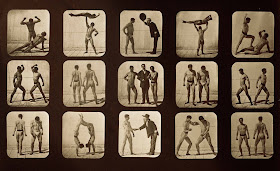Saturday, September 11, 2010
"Eadweard Muybridge" at Tate Britain
The pioneering Anglo-American photographer Eadweard Muybridge (1830-1904) is the focus of a new exhibition that opened earlier this week at Tate Britain. Bringing together more than 150 works, the exhibition demonstrates how Muybridge broke new ground in the emerging art form of photography.
Born in Kingston-upon-Thames in 1830, Muybridge (DNB bio here, Wiki bio here) studied photography in England before starting his career in the United States. Perhaps best known for his studies of animal and human subjects in motion, he was also a highly successful landscape and survey photographer, documentary artist, war correspondent, and inventor. Muybridge’s revolutionary techniques produced timeless images that have profoundly influenced generations of photographers, filmmakers, and artists, including Francis Bacon, Marcel Duchamp, Jasper Johns, Cy Twombly, and Douglas Gordon.
The exhibition, which was organized by the Corcoran Gallery of Art in Washington, D.C., is presented chronologically, with an emphasis on the rapid technological and cultural change that occurred during the second half of the nineteenth century. It features Muybridge's celebrated experimental series of motion-capture photographs, including The Attitudes of Animals in Motion (1881) and Animal Locomotion, a series of 781 collotype prints in 11 volumes published by the University of Pennsylvania in 1887. The exhibition also considers how Muybridge constructed, manipulated, and presented these photographs. A special highlight is an original "zoopraxiscope," a device Muybridge invented that projected his images in a way that created the illusion of movement.
Muybridge’s motion studies and carefully managed studio photographs of celebrities contrast with his panoramic landscapes of America. He was fascinated by change and progress and his photographs recorded both the natural beauty of this vast continent and the rapid modernization of its towns and cities. The exhibition includes many of his images of the Yosemite Valley, along with views of Alaska and Guatemala, urban panoramas of San Francisco, and a photographic survey of the construction of the Central Pacific, Union Pacific, and Californian Pacific railroads.
In conjunction with the exhibition, the Tate is launching a new iPhone photo app called "The Muybridgizer," which will allow users to freeze-frame the moving world around them just as Muybridge did and to apply grids and sepia tones that will simulate his motion-capture photos. The app is expected to be available in iTunes by the end of September.
"Eadweard Muybridge" runs through 16 January.
Shown at top: Eadweard Muybridge, Dancing (fancy.) (Movements. Female). Plate 188, Animal Locomotion (1887). Corcoran Gallery of Art, Washington, D.C., Museum Purchase, 87.7.188.
Shown above: Eadweard Muybridge, Athletes. Posturing. Plate 115, 1879, from The Attitudes of Animals in Motion (1881). Albumen silver print. Courtesy Special Collections, Stanford University Libraries.
Read more...
The Eadweard Muybridge Bequest (Muybridge returned to Kingston in the 1890s and when he died in 1904, he bequeathed his equipment and prints to Kingston Museum; this website provides an excellent overview of his life with extensive documentation and images)
"Muybridge: The Man Who Made Pictures Move," National Public Radio, 13 April 2010
"Iron Horses: Leland Stanford, Eadweard Muybridge, and the Industrialised Eye," Oxford Art Journal (October 2005) 28 (3): 407-428.
The Compleat Eadweard Muybridge: His Life, Work, and Legacy (a superb blog by Stephen Herbert with links to a wide range of resources)


Been reading about this and your post puts it so well. A man truly ahead of his time.
ReplyDelete